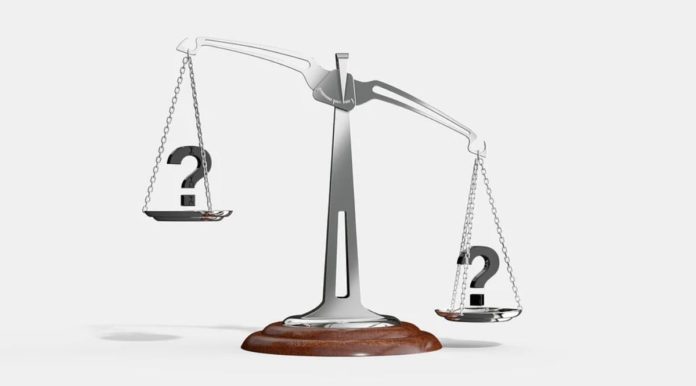What is Risk?
The first thing you should do as an investor is to know how to define your risk profile. To find out your risk profile, you first need to understand the concept of risk.
Risk can be defined as a dispersion of future returns. If you invest in something that has highly volatile returns, it is considered a risky investment.
If, on the other hand, you invest in something that has a fixed return rate, it would carry a minimal amount of risk.
Market Risk and Firm-Specific Risk
There are two types of risk: market risk and firm-specific risk. The main difference between the two is that systematic (= market) risk cannot be reduced by diversification.
If a systematic risk comes true – usually because of macroeconomic or political reasons – it affects the whole market. Therefore, diversifying your investment to different companies doesn’t reduce the risk you bear.
Firm-specific risk, on the other hand, can be reduced by diversifying your investments. Because specific risks affect a certain firm or industry, you can reduce the risk by diversifying your investments to a company or industry that doesn’t correlate with your current investment.
It is also important to realize the relationship between time and risk. Shorter investment time equals bigger risk. This is simply because volatility is usually higher in the short term.
If you invest in a company or a fund for just a couple of days or weeks, you have no idea what the returns are going to be. It is purely speculating on short-term returns. On the other hand, if you invest in the same stock or fund for 10 years, the odds of making positive returns are in your favor.
Because your success as an investor will highly depend on your risk management, you should take great care when defining your risk profile. Although everyone has their individual risk profile, there are a couple of factors that can be used as general guidelines.
The 3 Factors That Tell You How to Define Your Risk Profile
Age
3 Factors That Tell You How to Define Your Risk Profile
One of the main things that define your risk level is your age. Different periods in life often require different investment approaches.
Youth
Young investors can and should focus their investments purely on stocks. Younger people usually have fewer expenses, which means they have more money to invest, and therefore they can invest a larger portion of their income. This translates to more compounding returns in the later stages of life.
Youth is when you lay the foundation for your future wealth. As we know, accumulating wealth requires a certain amount of risk. If you expect higher returns, you must be ready to assume higher risk.
You can usually afford to take more risks when you’re young because there are fewer things you are responsible for. It is also comforting to remember that if you happen to make a royal cock-up and lose a major part of your investments, you still have plenty enough time to rebuild.
Parenthood and Settling Down
With age comes responsibility, and with great responsibility comes great expenses. In addition to yourself, you’re also responsible for the people around you. This limits the amount of risk you can take because the need for financial security is stronger.
You might also want to consider whether you have enough time to make your research about potential companies. If you don’t have enough time to delve into companies you invest in, your risk level will rise considerably.
When you find yourself making careless investment decisions, it might be smart to make monthly investments in passive index funds. If you decide to invest in funds, make sure you avoid the 3 most common mistakes in regular fund investing.
It’s worth noting that at this point in life you may have accumulated some amount of wealth, which means that it’s wise to adjust your risk level so that you will not only accumulate more but also maintain the wealth you have created.
Because the urge to bet on a wild card can be quite irresistible, I recommend setting aside a certain amount of money that you use purely on those ventures. About 10% of your portfolio is more than enough.
This limits your potential losses and allows you to make riskier investments without damaging your overall returns too much. 10% is also enough to make a difference if you happen to find something spectacular.
Retirement
The general rule is that the older you get, the more stable your income should be. You start to prefer bonds, real estate investments, and defensive, high dividend-paying companies instead of those risky may-be-ten-baggers-someday stocks.
This is not to say you shouldn’t be optimistic and invest in new and promising stocks when you’re older. You most certainly can, as long as it doesn’t compromise your finances.
Because your cost of living will probably rise the older you get, it is vital to have more liquidity than before. Riskier investments often require longer holding periods, which is why they’re not suitable for an investor who might need large amounts of cash on short notice.
You should also prepare for the possibility that you can’t take care of your investment as you could before. Therefore, your portfolio should be as self-sufficient as possible.
Retirement is usually also the phase where it’s most important to maintain the wealth you have accumulated. We take a closer look at this in the investment goals chapter.
Financial Status and Debt
Although age and life status are the main factors that define your risk level, your financial status is the reality in which you operate. It can give you more or less
For example, if you’re a high-income person with a manageable debt burden, you can afford to take more risk.
If, on the other hand, your expenses and debts compared to your income are high, it would be unwise to make risky investments. Now, you may think this is a no-brainer, but unfortunately in real life, it is not.
In my experience, the reason usually is that either the actual risk level is higher than the investors think, or they are overconfident about their investing skills (or luck). Either way, not good.
You should always remember that the bank will collect the debt whether you’re up for it or not. The worst-case scenario is that you are forced to sell your stocks at a loss to cover your debt payments, and still have debt left to pay.
A large amount of debt is especially dangerous during times of high inflation, stable wage levels, rising interest rates, and declining stock prices. In other words, you have less money to buy things and pay your debts. You will then have to resort to your stocks that are worth a lot less than before.
A secure financial status is the foundation of successful investing. It allows you to invest in the long-term and achieve those high compounding returns we’re all after.
That’s why it is so important to remember, that you should never risk your financial well-being in the stock market – no matter how promising the returns may be. It is far better to miss out on some opportunities than to be forced out of the markets entirely.
Investment goals
At some point in your investing career, you will move from accumulating wealth to maintaining what you have earned. This reflects directly on your risk level, because the more your wealth increases, the more careful you should be about preserving it.
Accumulating wealth requires more risk. If your goal is to build a substantial amount of wealth and be financially independent, your risk level will inevitably be higher. In the wealth accumulation phase, you can be fully invested in stocks.
It is important to realize that getting wealthy and staying wealthy are different things. Therefore, you should adjust your risk level accordingly. Staying wealthy requires less risk and more stability.
Stability is achieved through diversification across asset classes, which reduces your risk level. When the goal is to maintain your fortune, it is highly recommendable to diversify your investments.
Summary
Okay, so now you should be able to define your risk profile.
First, you should first understand what the nature of risk is. Unlike it is usually perceived, the risk is not a negative thing. It is just a concept that you use to measure the volatility of your investments, and volatility works in both ways. When you take a risk, you risk both negative and positive surprises.
You should only take as much risk as you can comfortably bear in the long term. The idea is to find a risk level that allows you to make decent returns without losing sleep.
Some of the risks you can manage by diversification, and some you can’t. You will always have bad years during bear markets, but that doesn’t mean you are necessarily doing something wrong.
It’s best not to change your desired risk level constantly. Only make adjustments if there are major changes in your life, financial status, or investment goals.
Investing requires a certain amount of optimism, but it should be balanced by a healthy amount of caution. Optimism is what creates wealth whereas caution is what maintains it.




